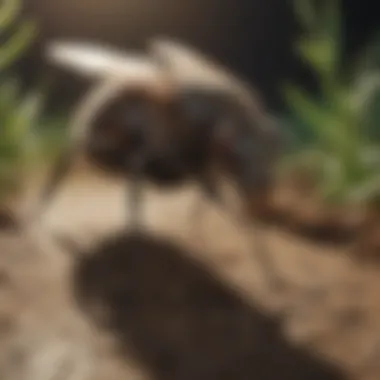Understanding Pest Control Treatment Costs Effectively


Intro
Understanding the costs related to pest control treatment is vital for both agriculture farmers and enthusiasts. This awareness goes beyond mere pricing; it encompasses the methods used, environmental impacts, and economic implications. Pest management strategies vary widely, influenced by factors such as the types of pests involved, the scale of infestation, and geographic location.
The increasing global interest in sustainable practices necessitates a keen grasp of how pest control approaches contribute to overall agricultural productivity. Furthermore, effective budgeting plays an essential role in pest management, impacting long-term profitability and sustainability in farming. As we delve into this topic, we will explore the core factors that shape costs, the evolution of pest control techniques, and practical applications to enhance understanding and budget management.
Foreword to Pest Control Treatment Costs
Pest control is an essential aspect for both residential and agricultural settings. Understanding the costs associated with pest control treatments is crucial for informed decision-making. This section will explore the significance of pest control in maintaining health and safety, as well as provide an overview of the factors that determine treatment costs. By grasping these concepts, farmers and agriculture enthusiasts can effectively plan their pest management strategies without overspending.
Importance of Pest Control
Effective pest control plays a vital role in agriculture and horticulture. Pests can cause significant damage to crops, leading to lower yields and reduced profitability. Additionally, some pests can threaten the health of livestock and human populations. The importance of pest control therefore cannot be overstated. Prompt and efficient pest management helps to protect not just the crops, but also the overall ecosystem. By investing in pest control, farmers safeguard their investments and ensure sustainable agricultural practices.
Overview of Treatment Costs
When considering pest control, it is essential to understand the various costs involved. Treatment costs can vary widely based on a number of factors:
- Type of pest: Different pests require different treatment methods, affecting the overall cost.
- Level of infestation: A minor pest problem may incur lower costs than a severe infestation.
- Location and accessibility: Remote areas may experience higher service fees due to increased travel time and effort.
- Treatment method selected: Chemical, biological, or physical treatments each come with distinct price points.
- Frequency of treatment: Regular treatments can lead to higher cumulative costs over time.
Recognizing the breakdown of treatment costs helps in budgeting and planning for effective pest management strategies.
Understanding these elements provides clarity on how to allocate resources for pest control effectively. By being aware of what influences treatment prices, farmers can make more economical choices that align with their specific situations.
Types of Pest Control Treatments
Understanding the types of pest control treatments is crucial for anyone involved in pest management. Each type has its own set of methods, advantages, and considerations. Selecting the right treatment can lead to effective pest elimination while ensuring safety for humans, animals, and the environment. With a variety of approaches available, knowing the best solution for specific situations is essential.
Chemical Pest Control
Chemical pest control remains one of the most widely used methods in handling pest infestations. This approach involves the application of substances that eliminate or repel pests. These chemicals can range from insecticides to herbicides, and their effectiveness lies in their ability to target specific pests based on their biology.
While chemical pest control provides instant results, it is important to consider the potential drawbacks. Prolonged use of chemicals can lead to pest resistance, making them less effective over time. Furthermore, there are safety concerns regarding the impact on non-target species, including pets and beneficial insects.
Biological Pest Control
Biological pest control employs natural predators or pathogens to manage pest populations. This method is often seen as environmentally friendly. For instance, ladybugs can control aphids, and certain nematodes target soil-dwelling pests. Biological control promotes ecological balance and reduces the reliance on synthetic chemicals.
However, this method requires a deep understanding of the pest's natural enemies. Successful implementation demands patience, as it may take time for biological agents to establish and achieve noticeable results.


Physical and Mechanical Control
Physical and mechanical control strategies involve direct removal of pests or blocking their access to resources. Methods can include traps, barriers, and vacuuming. For example, sealing cracks can prevent rodents from entering buildings, while placing traps can eliminate insects or smaller pests.
This approach has its advantages as it typically has no negative environmental impact. However, it may be labor-intensive and can require frequent monitoring to be effective.
Cultural Pest Control
Cultural pest control refers to the changes in agricultural practices to prevent pest development. This can include crop rotation, altering planting schedules, and optimizing soil health to deter pests. By fostering an environment less conducive to pest growth, farmers can reduce the likelihood of infestations.
While cultural methods are often sustainable, they may require a shift in traditional practices and increased knowledge. Adjusting cultural practices can be a long-term investment in pest management.
By understanding these pest control treatments and their implications, users can make informed decisions. Each method contributes uniquely to pest control, and often, a combination of strategies is the most effective way to handle pest populations.
Factors Influencing Pest Control Treatment Costs
Understanding the various elements that affect pest control treatment costs is essential for both individuals and businesses. It helps create a clear picture of what to expect. Knowing these factors allows for better budgeting and planning in pest management strategies. Each specific element can lead to considerable variation in pricing, making it crucial for farmers and pest control service seekers to understand them well.
Type of Pest
The kind of pest involved plays a significant role in determining treatment costs. Different pests, such as rodents, termites, or insects, require unique approaches. For example, termites need specialized treatments like baiting systems or spot treatments. Meanwhile, general insect pests may be managed with standard insecticides. The complexity of pest biology and behavior necessitates tailored treatments and thus influences pricing.
Level of Infestation
Another critical aspect is the level of infestation. A minor issue might be solved with a single visit, whereas a severe infestation could require multiple interventions. For example, if a farmer discovers a colony of aphids destroying crops, early detection could mean a lower cost for treatment. On the other hand, if the infestation reaches a point where crops are significantly damaged, this could require extensive treatment plans and incur higher costs.
Location and Accessibility
Location can also affect treatment costs. If the pest-infested area is remote or difficult to access, additional charges may apply. Urban areas might have higher operational costs for pest control companies due to regulations and logistical challenges. On the farm, areas with dense vegetation or hard-to-reach spaces may also incur increased costs because of the extra effort needed to treat them. Accessibility of the property plays a big role in the price you will pay.
Treatment Method Selected
The chosen treatment method directly impacts pricing as well. Non-chemical methods might seem cost-effective initially, but can require more time and labor. Chemical treatments, while efficient, often manifest a higher initial investment. Choosing a method such as integrated pest management approaches can lead to variable costs based on the strategies implemented. Factors such as safety and environmental impact can also influence selections and thus affect overall expenses.
Frequency of Treatment
Lastly, the frequency of treatments contributes to overall pest control costs. Some pests may require a one-time treatment, while others might necessitate regular monitoring and treatment sessions, especially in sensitive environments like agricultural fields. Establishing a schedule can help optimize treatment effectiveness and control costs effectively. The more frequent the treatments, the more the total investment will increase.
The interplay of these factors can provide clarity to budgeting for pest control and adjusting strategies as needed for long-term management.


Average Costs Associated with Pest Control
Understanding the average costs associated with pest control is essential for anyone considering pest management solutions. This section aims to provide clarity on the financial aspects of pest control. It highlights how different settings, such as residential, commercial, and agricultural, each carry unique pricing structures. Knowing these costs can help individuals and businesses make informed decisions, ensuring they allocate their budgets effectively.
Residential Pest Control Costs
When it comes to residential pest control, costs can vary significantly based on several factors. On average, homeowners may expect to pay anywhere from $200 to $500 for initial treatments, depending on the type of pest and the extent of the infestation. For instance, common pests like ants or cockroaches may require a lower investment compared to treatments for termites or bed bugs, which can be considerably higher.
Additionally, recurring services often come into play for ongoing pest management. Many pest control companies offer packages that include quarterly or monthly inspections and treatments, which can cost between $40 to $300 per visit. This approach can be financially wise, particularly for homeowners in areas prone to infestations.
"Investing in regular pest control can prevent larger expenses in the future due to extensive damage or infestation."
Commercial Pest Control Costs
Commercial pest control costs often exceed residential expenses due to the scale and complexity of operations in businesses. On average, companies might allocate $500 to $2,000 depending on the type of pest and the size of the facility. For example, food-related businesses such as restaurants or grocery stores face stringent regulations. This often necessitates more frequent treatments and higher costs to comply with health standards.
Furthermore, many companies opt for preventive pest management services, which could range from monthly to quarterly treatments. Such services can require an investment between $100 to $1,000 per visit based on the delivery model and the pest control methods employed.
Agricultural Pest Control Costs
Agricultural pest control costs are inherently tied to the scale of the agricultural operation and the specific types of pests targeted. Farmers may find these costs on the higher end of the spectrum, often ranging from $200 to several thousand dollars per application.
The choice between chemical and biological pest control methods significantly affects pricing. Chemical treatments, while effective, can lead to additional costs associated with safety equipment, regulation compliance, and possible crop loss due to pesticide restrictions. Organic or biological methods might have lower treatment costs but may require different strategic planning for efficacy.
Moreover, the frequency of pest control applications can also contribute to overall costs. Many farmers conduct regular monitoring programs, which adds further costs, with some comprehensive plans ranging from $500 to $5,000 annually, depending on the crop type and pest concerns.
Understanding these average costs is crucial for effective budget planning and can guide individuals and businesses in selecting the most appropriate pest control strategy.
Long-term Financial Considerations
Understanding the long-term financial considerations of pest control is crucial for both individual homeowners and agricultural operators. Effective pest management is not just about immediate costs; it encompasses a thorough analysis of future expenses and potential savings derived from both effective treatments and preventative strategies. The importance of this section lies in its focus on ensuring a sustainable, cost-effective approach that safeguards investments over time.
Cost-Benefit Analysis of Pest Control
Conducting a cost-benefit analysis is an essential step that allows one to weigh the expenditures of pest control treatments against the benefits received. This analysis should consider several key factors:
- Initial Treatment Costs: These often include inspection fees, treatment application, and follow-up visits.
- Long-term Savings: Efficient pest control can lead to decreased need for future treatments and reduced damage to property or crops, translating to significant savings.
- Health and Safety Expenses: The impact of pests on health can lead to expenses related to medical treatments and loss of productivity, which should be factored into the overall calculation.
- Economic Impact: For agricultural entities, pest infestations can threaten crop yields, directly impacting profitability. Understanding how to mitigate these risks through intelligent pest management can lead to sustained income.
The return on investment for pest control often far outweighs the initial costs when approached thoughtfully.


Investing in Preventative Measures
Investing in preventative measures can be seen as a proactive strategy that mitigates future financial burdens. This investment may come in various forms:
- Educational Efforts: Training workers on identifying pest problems early helps in reducing the extent of infestations and ensures quicker action when needed.
- Regular Maintenance: Scheduled inspections by professionals can progressively reduce the risk of infestation, leading to lower emergency treatment costs.
- Physical Barriers: Employing physical forms of control, like installing screens or traps, creates a frontline defense against pests, thus averting expensive treatments down the line.
- Cultural Practices: Altering farming practices can limit pest attraction. Crop rotation or optimal planting dates can disrupt pest cycles.
Comparison of DIY versus Professional Treatments
When tackling pest issues, individuals often face the choice between do-it-yourself (DIY) solutions and professional pest control services. This decision is significant as it can affect not just the immediate financial expenditure, but also the long-term efficacy of the treatment and the potential for recurrence. Understanding the nuances of both options allows homeowners and agricultural stakeholders to make informed decisions based on their specific needs and circumstances.
Cost Implications of DIY Treatments
DIY pest control can appear to be more economical at first glance. Many homeowners gravitate towards this approach, primarily due to lower upfront costs. Solutions like over-the-counter insecticides, traps, and baits are readily available in stores and online. However, the overall cost of DIY measures can vary widely based on several factors:
- Materials and Supplies: Depending on the pest type and the severity of the infestation, the costs may escalate with the purchase of multiple products. For instance, buying various insecticides can add up, especially if initial attempts fail.
- Repeated Treatments: If the pest problem is persistent, repeated applications of DIY solutions may be necessary, thus increasing overall expenses.
- Missed Issues: DIY treatments often address only visible pests. Hidden infestations may go untreated, leading to further complications and ultimately higher costs than originally anticipated.
Despite the lower initial cost, the long-term effectiveness of DIY approaches is often questionable, especially against stubborn pests. Thus, while the DIY method can be appealing, it may not always be the most cost-effective or efficient choice in the long run.
Professional Treatment Costs and Value
Engaging professional pest control services offers a different set of financial implications. While the initial investment is typically higher than DIY methods, the value gained can outweigh the costs, especially in complex cases. Here are important considerations for professional treatments:
- Expertise and Knowledge: Trained professionals bring expertise that can effectively identify and treat infestations that may not be apparent to the average person. This includes understanding pest biology and behavior, which can lead to better outcomes.
- Comprehensive Solutions: Professionals often provide integrated pest management, ensuring that all aspects of the issue are handled. This method not only addresses existing problems but also focuses on prevention, potentially saving money over time.
- Long-term Guarantees: Many pest control companies offer guarantees on their services, meaning if pests return, further treatments are often included at no additional cost.
In many cases, the initial investment in professional services pays off by minimizing the risk of future infestations and extending the effectiveness of treatments. Thus, while DIY methods may seem to save money initially, professional treatments can provide significant value in terms of effectiveness and peace of mind.
Finale: Making Informed Decisions
In the realm of pest control, making informed decisions is essential for effective management and financial planning. This article serves as a vital resource for understanding the complexities associated with the costs of pest control treatments. It emphasizes the importance of evaluating individual pest control needs and the various factors that influence treatment costs.
Evaluating Pest Control Needs
Evaluating pest control needs requires a comprehensive understanding of the specific pest issues one faces. Each type of pest presents unique challenges, and identifying the species involved can dramatically affect treatment selection and associated costs. Factors such as the level of infestation, property type, and specific environmental conditions play a significant role in establishing the necessary intervention strategies.
Moreover, it is critical to assess whether immediate action or preventive measures are needed. For instance, agricultural farmers may encounter pests that threaten crop yield. Here, early identification and control can deter long-term damage and financial loss. Ultimately, accurately evaluating these needs enables individuals and businesses to allocate their budgets more effectively, ensuring that resources are directed toward the most impactful treatments.
Summary of Cost Factors
Several cost factors influence the overall expenditure related to pest control treatments. These include:
- Type of Pest: The specific pest species often dictates the treatment approach and its corresponding cost. Common pests like rodents may require different strategies compared to more specialized insects, like termites.
- Level of Infestation: A minor infestation may be manageable with a single treatment, while a larger, entrenched infestation might necessitate multiple sessions, escalating costs.
- Location and Accessibility: The location of the pest problem can also impact treatment cost. For example, pest control in densely populated urban areas may attract higher fees compared to rural settings due to various constraints.
- Treatment Method Selected: The choice between DIY approaches and professional treatments introduces varied costs. While do-it-yourself methods can provide immediate savings, they may not always yield effective results, leading to greater long-term expenditures.
- Frequency of Treatment: Regular pest control maintenance can lead to cumulative costs over time. Whether it’s seasonal or ongoing treatment, such frequency should be factored into any comprehensive pest control budget.
By understanding these key cost factors, those facing pest challenges can make strategically informed decisions that not only address current infestations but also establish ongoing management systems to prevent future issues.
"Understanding the costs and factors involved in pest control helps to streamline efforts and maximize the effectiveness of treatments."
In summary, a knowledgeable and nuanced approach to pest control costs ensures that investments lead to successful, sustainable outcomes.

